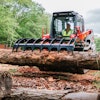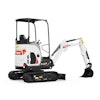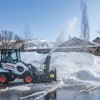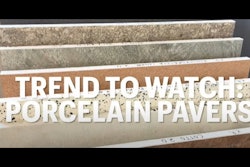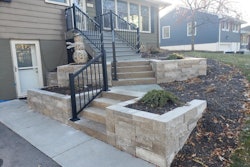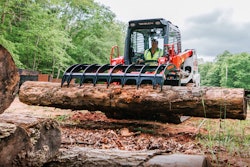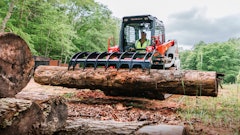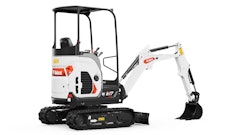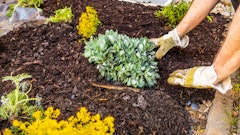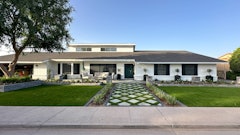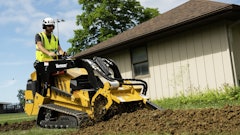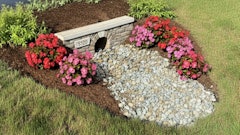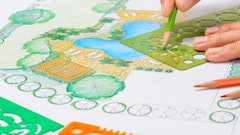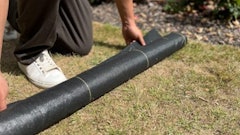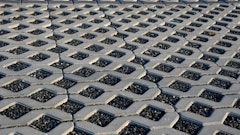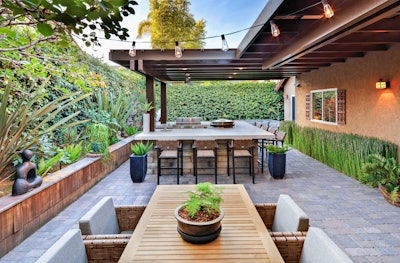
As residential (and even commercial customers) continue their zeal for outdoor spaces, it's up to design-build firms to keep up their end of the deal in delivering those spaces.
To help them do so, hardscape and lighting experts describe the latest trends in the space.
Hardscaping
1. Bringing the outdoors in
Since the COVID pandemic of 2020, more homeowners are looking to create outdoor areas that serve multiple purposes, enabling them to maximize the way they enjoy and utilize every inch of their yard, says Aaron Brundage, director of operations at System Pavers.
“Whether it’s expanding their living space with an outdoor kitchen or building a pergola that doubles as an outdoor dining area, this trend hits on the need for more versatile home environments,” Brundage says. “The desire for multipurpose outdoor areas has been on the rise as more people work remotely and want to invest in upgrading their home and surroundings.”
Joe Raboine, vice president of design, Oldcastle APG, agrees that customers are continuing to seek outdoor spaces.
“Most of us are stuck indoors most of the day, and it’s important we try to find ways to maximize our time outdoors, as it is beneficial for both mental and physical well-being,” Raboine says. “People will continue investing in outdoor living spaces and look for creative ways to use their space, such as outdoor exercise or work areas.”
A few other examples of these multifaceted living spaces include fire pits and outdoor kitchens.
With people spending more time at home, homeowners are ranking privacy as a top priority.
“The incorporation of products like pergolas, screen panels and other privacy structures can shield outdoor spaces from neighborhood or roadway views, allowing for more comfort,” Raboine says.
2. Porcelain pavers
As the prices of porcelain have decreased, their demand has increased, according to Travis Smith, sales coordinator for Heritage Landscape Supply Group.
"Porcelain has proven to be the most durable product available in hardscapes including stain resistance, breaking strength, compressive psi loads and more with the testing to prove it," Smith says. "The presumption in the past was that porcelain was expensive, but these days, it comes in at less than most high-end pavers. Technology gives us the ability to create any look or color from any corner of the world or whatever our imaginations give us at an affordable price."
Additionally, Smith says that manufacturers have refined the installation process and that porcelain pavers allow for continuity of a surface indoors and outdoors.
“When porcelain pavers first showed up, we told everyone to install them like concrete pavers, and that was a half-truth. Now, with plastic grid systems and a better understanding of what aggregates should be used, we can stand behind our own industry specs with confidence,” Smith says. “Also, installation over concrete has changed drastically with a ton of new products geared toward the hardscaper and not necessarily the tile setter.”
Items contractors need to keep in mind when installing porcelain pavers include:
- Porcelain installation has a lot of similarities to natural stone and concrete products, but the products need to be rated for porcelain.
- Cutting is different and initially much harder than the products hardscapers have grown accustomed to. The blades need to be porcelain blades, and a 14-inch saw isn’t the way to go for complex cuts, but with a small amount of patience and allowing the tools to do their jobs, any crew will be comfortable with ANY cutting situation after a project or two.
3. Natural biophilic earth tones
Another trend stemming from 2020 is the use of earth tones within the design, according to Beth McBride, business development, Heritage Landscape Supply Group.
“A lot of this stemmed from the pandemic when people were spending more time outside,” McBride says.
She adds that many people are going for a more timeless look.
“They’re doing (renovations) one piece at a time,” McBride says.
4. Sustainable materials
Going hand in hand with biophilic design, the hardscaping industry has also experienced a shift toward using sustainable and eco-friendly materials.
“This is particularly true when it comes to decking,” Brundage says. “Homeowners are opting for composite decking, which is sustainably made of recycled materials while being incredibly durable and easy to maintain.”
5. Cool-toned, textured pavers
Opposing the earth tones trend, cool-toned colors have also seen a surge in popularity, with homeowners opting for pavers in varying gray tones that work well with modern designs, according to Raboine.
“Texture is also important, as it provides more depth and dimension to a design,” Raboine says. “Textured pavers can really elevate an outdoor space and allow designers and homeowners to play with different tones and materials.”
6. "Nontraditional" landscapes
Looking ahead, customers may also want to create landscaped areas in spaces that they didn’t previously exist, Smith says.
“In the future, we’ll see vertical landscapes in cityscapes and even up houses,” Smith says. “This will increase the amount of available hardscape space.”
Raboine adds that the trend of microscapes will also continue, as people in larger cities or with smaller lot sizes find ways to create an outdoor space.
Lighting
1. App-controlled lighting
In the lighting sector, more homeowners are requesting app-controlled lighting, where they can control zoning, dimming, kelvin adjustment and custom scene creation for holiday and special events, says Jim Frederick, key account manager, Tru-Scapes.
“What was a specialty item just two years ago has become a No. 1 request,” Frederick says.
He adds that zoning allows for “layering” within the design, allowing a backyard lighting system to be adjusted for many moods with multiple zones of light. Kelvin adjustment from warm to cool light allows for fine-tuning to best accentuate key features in the outdoor space.
“Before this option, we had to install unique fixtures for lamps; now we can utilize a much smaller library of lamps and adjust as we see fit,” Frederick says. “All of this control can be done with handheld devices.”
2. LED technology
Similar to hardscape eco-friendly trends, LED lighting allows homeowners to reduce expenses and live more sustainably.
“Recent advancements in technology mean LED lighting has evolved to have improved energy efficiency and a wider range of color options,” Brundage says. “Many people now use LED lights to highlight hardscape features, illuminate pathways, increase after-dark safety and add ambiance. The energy efficiency of LED lighting is a major reason for its increase in popularity as it can provide substantial cost savings in utilities over time.”
Rick McNabb, manager of lighting and specialty products, Heritage Landscape Group, Region South, adds that LED transformers that are “zone-able” make it easier for lighting pros to install customized lighting systems.
3. Nontraditional lighting
Other forms of lighting have also gained popularity, such as wash lights and mini lights, McNabb says.
“Placing wash lights 8 inches from the house underneath windows eliminates the vertical striping of light going up the exterior wall,” McNabb says. “Mini lights under windows are also a good choice because the areas under windows don’t need as many lumens. Mini lights have an appealing design and are easy to conceal.”
Another popular trend, Brundage says, is called moonlighting, which involves placing lights high up in trees or on structures to create a soft, natural lighting effect that’s similar to moonlight filtering down through the branches.
“It adds depth and drama while maintaining a natural feel,” Brundage says.
For more on porcelain paver trends, follow this link.

